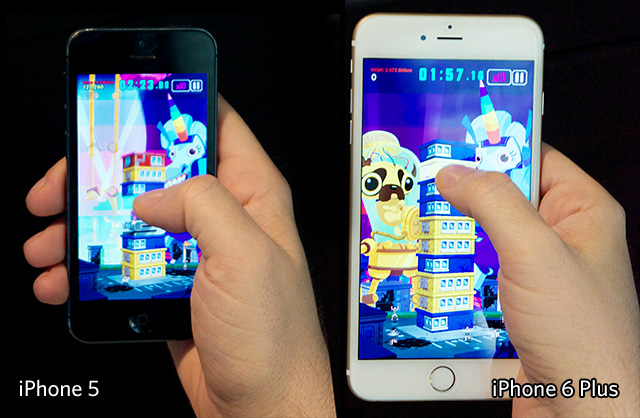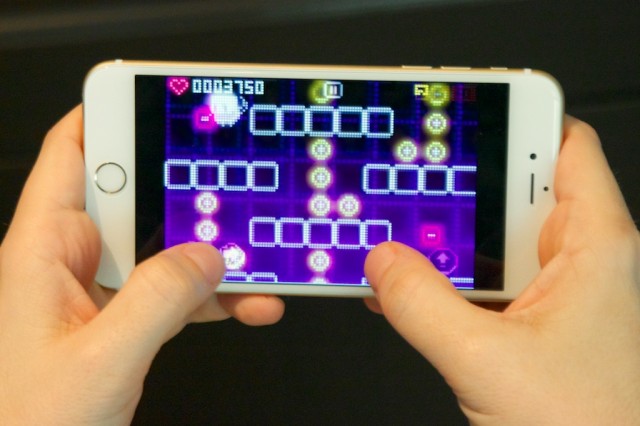When I first heard about the iPhone 6 Plus during Apple's announcement last month, my mind immediately jumped to the 3DS XL. That 2012 update to the portable platform made 3DS games both more comfortable to look at and the system itself much more comfortable to hold in adult-sized hands. The super-sized iPhone 6 Plus does the same thing for what has become one of the most popular gaming platforms ever, giving new life to games that could feel a bit cramped on smaller iPhone screens.
Apple isn't the first to discover the mobile gaming potential of a bigger screen, of course—Android and Windows Phones have sported displays as big or bigger than the iPhone 6 Plus for years. While those platforms are slowly catching up to iOS in terms of game selection and features, the iTunes Store still has a number of important gaming exclusives and a huge back catalog of great games, which make it the platform of choice for mobile gaming.
After our own Andrew Cunningham took a deep dive into the iPhone 6 Plus' capabilities as a productivity and communications device, I put the phone through its paces as a portable gaming machine. After a week tapping, swiping, and tilting through dozens of games, I found the iPhone 6 Plus a bit unwieldy for games designed to be played with one hand—but a thorough improvement over previous iPhones for just about everything else.
Too big for one hand
Let's get that major negative out of the way first: the iPhone 6 Plus is simply too big to comfortably hold and manipulate for most one-handed games. On the iPhone 5, I can easily and securely grip the sides of the phone in my fingers so that my thumb can reach from one corner to the other relatively easily.
Playing games in the same way on the iPhone 6 Plus is an exercise in frustration; it's just too wide to get that same grip while still keeping the thumb movable (at least in my hands). The best solution I've found involves resting the back of the phone on my fingertips and tilting the phone almost parallel to the ground so that gravity helps hold it in place. It's not a secure way to hold a phone, and it gets less secure as you shift your thumb (and the weight of your hand) to actually tap at the games.

What's more, the extended screen real estate makes it tough to reach from one corner of the screen to the other with the same thumb that's holding the device. In practice, this wasn't a huge deal—the action on most one-handed iOS games I tried focus the actual tapping and swiping action near the center of the screen. And some one-handed titles, like Temple Run, feature controls that allow for swipes anywhere on the screen, which made position even less important.
That said, I did find myself awkwardly trying to shift or adjust the phone's position in my hand many times so my thumb could reach some far off tap target. Sometimes I'd find myself unconsciously reaching my off hand up to hold or steady the device, or I would place the phone against my chest to adjust my position. The iPhone 6 Plus' "Reachability" feature does work with games, and it can be helpful for turn-based titles like Words with Friends or Bookworm Heroes, but it's much too inefficient to be of any use for games that require reflexes.
How big of a problem is this one-handed gaming backslide? That obviously depends on the types of iPhone games you're playing and the situations you use the phone in. Personally, I found myself regretting the larger phone when trying to play a quick round of Bejeweled Blitz while holding a bag of groceries in a checkout line, or swiping through a game of Super Monsters Ate My Condo while holding a sleeping baby in the other arm. These and many other games were perfectly playable if I had two hands free—one to hold the device, the other to tap and swipe away—but when that wasn't an option, the iPhone 6 Plus was actually worse than the iPhone 5 I usually play on.
Bigger is better (with two hands)
In general, though, while testing the iPhone 6 Plus' gaming potential, I was surprised by how many of my favorite iPhone games pretty much require two hands even when played on a smaller phone. A game like Fruit Ninja or Desert Golfing may technically only require one finger to play, but in practice, you end up holding the device with one hand and swiping with the other index finger. And if you have two hands free, almost every game is significantly improved on the iPhone 6 Plus.
In general, I'm not a fan of iOS games that use an on-screen "virtual control pad" and button overlays as the control method. Besides requiring players to cover valuable screen real estate with their thumbs, the cramped space and lack of tactile feedback made these options awkward at best and unusable at worst on older iPhones. The iPhone 6 Plus doesn't fix these problems completely, but it does lessen them. The increased physical size of the controls on games like Super Crate Box, League of Evil, Pix N Love Rush, and Dead Trigger led to more comfort and fewer mistaken taps when moving up from the iPhone 5 to the 6 Plus (oddly enough, I wasn't able to get Age of Zombies to run at all on my 6 Plus, even though it ran fine on an iPhone 5 with iOS 8).


Plus, it's less annoying to keep your fingers welded to the on-screen controls when more overall screen space remains uncovered (see above). Even games with "two-side" tap controls, like Duet or Pinball Arcade, benefit from having proportionally less of the screen covered by opaque thumbs.
Plenty of other games make great use of the extra screen space, too. Eliss and Eliss Infinity are the best examples I've found. I had long ago given up on trying to pull apart and merge these games' circles on the tiny iPhone screen, opting to play on the iPad instead, but the expanded screen size on the 6 Plus suddenly makes them playable on a pocket-sized device. For other games, like Desert Golfing or Super Hexagon, it's simply easier to see and react to what's going on without squinting, thanks to the bigger screen.
For another set of games, including Pinball Arcade, Zen Bound, Smash Hit, and Monument Valley, a bigger screen just makes it easier to admire the high-res retina graphics. The effect isn't quite as striking as playing on an iPad (or even an iPad Mini), but it's still nice to have the extra graphical space in a more convenient and portable form.
I also noticed some benefits when playing tilt-based games on the iPhone 6 Plus; titles like AaAaAA!!! A Reckless Disregard for Gravity, Knightmare Tower, or Tilt to Live 2 felt a bit more precise and easier to position on the new phone compared to the iPhone 5. I can't really say if this is due to the 6 Plus' addition of a second accelerometer for more accurate tilt sensitivity or if it's just easier to make more accurate, fine-grained shifts when holding a thinner, larger device with a few ounces more heft to it. Either way, it's hard to go back to the iPhone 5 for these games.
It's a shame that the iPhone 6 Plus is too big to effectively use for one-handed gaming, because for everything else it has quickly become my favorite mobile gaming device. The 6 Plus strikes a good balance for gaming, being large enough to avoid the "fat fingers" problems somewhat inherent to gaming on previous iPhones, but it's not as unwieldy as an iPad or iPad Mini for gaming on the go. And I haven't even mentioned how the increased battery life is a godsend when playing graphically intense games. If you're at all interested in using your iPhone as a gaming device, do consider an upgrade.
reader comments
52